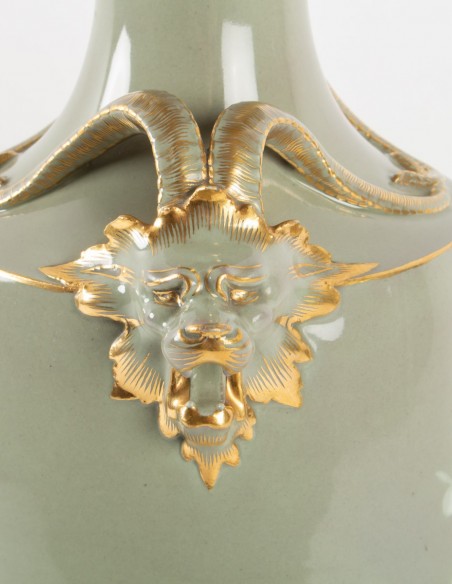Rare double-headed porcelain vase with "chameleon paste" on pedestal. It is decorated with a fine decoration of foliage and bird on the branch and dragonflies, treated in "dough on dough" on a celadon background. Two stylized roaring ram-horned lions' heads outlined in gilding rest on the shoulders. Brands: S 64 / N topped with a crown imperial and marked decorated a Sèvres 64, in the neck of the vase and 65 under the base. Probably a model of Louis-Léopold-Jules Gély (1820-1893), active at the Manufacture de Sèvres between 1850 and 1889 as a sculptor-modeler. He was, alongside Taxile Doom and Mark-Louis-Emmanuel Solon, one of the specialists of the so-called "dough on dough" technique
Chameleon paste or changeable paste was invented by the chemist Salvetat for the Universal Exhibition of 1863. It consists in the production of a paste whose color changes depending on the lighting. Thanks to a vanadium oxide and a Cerium oxide, the background color is gray under natural light, and purple under an artificial color. This color background technique was preferred for paste-on-paste application paste decorations.
After London organized a second exhibition in 1862, Paris in turn prepared for 1867 a major international gathering announced by an imperial decree of June 22, 1863. It was necessary "that it should be more completely universal than the previous ones, and that, for this purpose, it should include, as much as possible, works of art, industrial products from all regions, and, in general, the manifestations of all branches of human activity". I report a restoration on the collar, as for the brand here is the answer of Mr Antoine d'albis :
"There is no doubt that your vase is not in waste. The little retreat on the brand is classic. It is due to the fat that is used to decal it To print the brand we mix chromium oxide with a special oil made in Sèvres, the fat repels the enamel hence the retreat on the brand ".
- Antoine d'albis is a chemist, former head of the laboratory of the Manufacture de Sèvres, president of the society of Friends of the Museum of Ceramics. He is the author of a "Treatise on Sèvres porcelain, earthenware and soft paste" (Dossier de l'art n°54: The conquest of hard porcelain). Antoine d'albis is a ceramic engineer. He is a specialist in eighteenth-century porcelain and that of Vincennes (1740-1756) in particular. Great-grandson of Theodore Haviland, he has, thanks to this family heritage passed down from father to son for five generations, benefited from one hundred and fifty years of uninterrupted experience and practice in the field of collectible porcelain. At the service of the Manufacture de Sèvres since 1965, he has continued his entire career there -
Chameleon paste or changeable paste was invented by the chemist Salvetat for the Universal Exhibition of 1863. It consists in the production of a paste whose color changes depending on the lighting. Thanks to a vanadium oxide and a Cerium oxide, the background color is gray under natural light, and purple under an artificial color. This color background technique was preferred for paste-on-paste application paste decorations.
After London organized a second exhibition in 1862, Paris in turn prepared for 1867 a major international gathering announced by an imperial decree of June 22, 1863. It was necessary "that it should be more completely universal than the previous ones, and that, for this purpose, it should include, as much as possible, works of art, industrial products from all regions, and, in general, the manifestations of all branches of human activity". I report a restoration on the collar, as for the brand here is the answer of Mr Antoine d'albis :
"There is no doubt that your vase is not in waste. The little retreat on the brand is classic. It is due to the fat that is used to decal it To print the brand we mix chromium oxide with a special oil made in Sèvres, the fat repels the enamel hence the retreat on the brand ".
- Antoine d'albis is a chemist, former head of the laboratory of the Manufacture de Sèvres, president of the society of Friends of the Museum of Ceramics. He is the author of a "Treatise on Sèvres porcelain, earthenware and soft paste" (Dossier de l'art n°54: The conquest of hard porcelain). Antoine d'albis is a ceramic engineer. He is a specialist in eighteenth-century porcelain and that of Vincennes (1740-1756) in particular. Great-grandson of Theodore Haviland, he has, thanks to this family heritage passed down from father to son for five generations, benefited from one hundred and fifty years of uninterrupted experience and practice in the field of collectible porcelain. At the service of the Manufacture de Sèvres since 1965, he has continued his entire career there -

 En
En  Fr
Fr


















